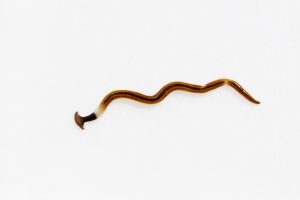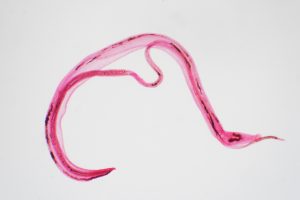Soil-Transmitted Helminths
What are soil-transmitted helminths?
Soil-transmitted helminths (STHs) are a group of intestinal parasites that thrive in areas with warm, humid soil and poor sanitation. STHs are common in tropical and subtropical areas, especially in sub-Saharan Africa, the Americas, and East Asia, where some communities do not have access to adequate water and sanitation. The World Health Organization (WHO) estimates more than 1.5 billion people are infected with STH worldwide. That is approximately 24% of the world’s population. The human, economic, and societal impacts of STH infections are significant because these diseases can result in disabling chronic conditions, delayed growth and cognitive development, severe social stigma, and lost economic productivity.
The most common STH parasites are:
 Ascaris lumbricoides (roundworm)
Ascaris lumbricoides (roundworm)
This parasite lives in the small intestine, where the female worms can grow up to 30 cm in length. Children are often infected more frequently and with a higher worm burden than adults through contact with soil contaminated with roundworm eggs. Childhood growth can be restricted and severe infections can impair intellectual and cognitive development.
 Necator americanus, Ancylostoma duodenale (hookworm)
Necator americanus, Ancylostoma duodenale (hookworm)
Hookworm larvae enter the body through skin, before they mature as they travel to the small intestine. They then attach to the wall of the intestine to feed. Children and women of reproductive age are most at risk for the symptoms of hookworm as blood loss can result in iron-deficiency anaemia and malnutrition.
 Trichuris trichiura (whipworm)
Trichuris trichiura (whipworm)
Whipworm enters the human body through contact with eggs in the soil. The eggs hatch in the small intestine, then attach to the large intestine causing blood loss and loss of nutrients. Childhood growth can be restricted and severe infections can impair intellectual and cognitive development.
How are STHs treated in communities?
Current deworming programs focus on administering treatment to pre-school and school-aged children once or twice a year.
How are diseases transmitted?

Adult STHs maturing in the intestine produce thousands of eggs a day. STHs are transmitted when infected people shed eggs in feces that then contaminate soil or water. The eggs are then ingested by others or actively penetrate their skin as larval worms. The cycle will continue unless the transmission is broken. And therein lies the solution to break the cycle: programs that treat everyone, in all households, more than once a year.